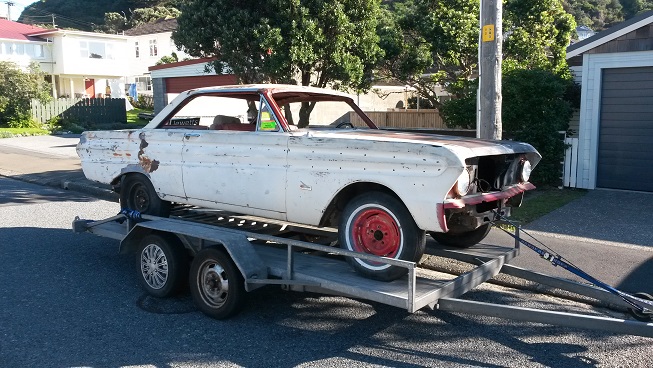-
Semi-Pro Racer

BUILD THREAD For 1964 Falcon Sprint to Monte Carlo Rallye FIA spec'
It all started looking at cool cars on the net, as you all do. and what caught my eye was this 1964 Falcon Sprint, first glance it looked pretty rough. But upon looking further it had very little rust, but the usual fair share of 50+ years of use, love and abuse.
So I bought it! .. Just like that.
I always liked the 63-64 muscle era, very raw and a very developing time for high performance cars.
These Falcons designed in the late 50s, the first 1960 Falcon rolled off the assembly line. in late 1959!
They were mass produced and were originally intended to have a 6 cylinder engine as a low cost entry for Mum Dad and the kids.
Things changed by 1964 and the big 3 (Ford, Mopar, GM) performance programs were in full swing. By then Ford had stuffed a 260ci V8 into the Falcon but the 64 Mercurys had 289s also and many with the 289 K hipo engine. There were also a lot of Fairlanes built with 289 K engines. Particularly in Canada where the right hand drive export cars came from, Many were 289K hipo engines and many came to NZ.
So in 1964, 8 Falcon Rallye Sprints were entered into the Monte Carlo Rally in full race trim courtesy of Holman Moody, who prepared 15 cars for Ford, 14 cars went to Alan Mann Racing in the UK to be further rally prepared, managed & raced at the Monte Carlo Rally. (H-M built 15 cars in total.)
1 Falcon was raced at Daytona together with the prototype 427 Fairlane in 1964. A number of 1964 cars including some Mercurys also went to compete in the East African rally. Ford offered a Regular Production Option (RPO) for the Falcon for 1964 to comply with the minimum of 1000 vehicles were produced.
At the same time in the USA Ford decided to stuff the 1964 Falcon with 425hp 427 Hi Riser big block and 4 speed and these were drag raced as AFX race cars and hugely competitive at the time for a 1250kg (2755lb) car, and very much lighter in drag trim.
To try to get the weight down close to the FIA 1250 homologated weight of 980kg, (they never got there but would have been best guess circa 1150kg) Holman Moody made a lot of changes for the 1964 Falcon Rallye Sprint for Monte Carlo Rallye: Fiberglass body panels, aluminum bumpers, 4 pot disc brakes, stiffer & lower suspension, adjustable koni shocks, quicker steering, close ratio T10 4 speed gearbox, Stump pulling 4.51 ratio 9 inch limited slip diff. The 289K engine was reworked with a twin 4 barrel Carter AFB Carburetors, 12.1 compression forged TRW Pistons (Fuel had lead in those days!) Modified heads, factory exhaust headers for better flow, 15 inch rims and skinny cross bias radial (Dunlop) tyres!, The factory dual point distributors (Rare C2FF-12127 with locked Vac adv) were running 38 degrees of maximum advance and all this meant about 340hp+ for the competition engines at the time. A quick car for 1964. Holman Moody made many other modifications to make the car perform well, as well as Alan Mann Racing.
So with all that, I bought this old dead looking 1964 car back to my nice warm garage as a rolling car needing more than a bit of TLC.
I found out the car sat in the desert for years somewhere in California and lucky as it was well preserved with about 7kg of California desert and 3 mouse nests, a dozen spider webs (All dead after fumigation)and an ash tray full of US coins.
So I started to strip it and decided to do this build.
Here is a pic of the car on day 1
Last edited by Paul B; 02-16-2020 at 10:11 PM.
Reason: Corrections, Typo
 Posting Permissions
Posting Permissions
- You may not post new threads
- You may not post replies
- You may not post attachments
- You may not edit your posts
-
Forum Rules







 Reply With Quote
Reply With Quote